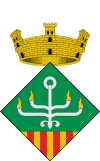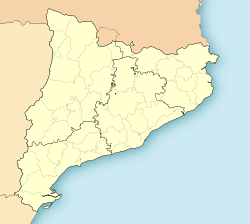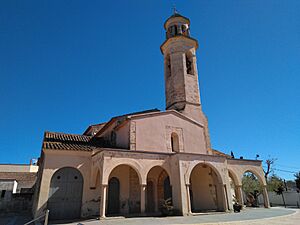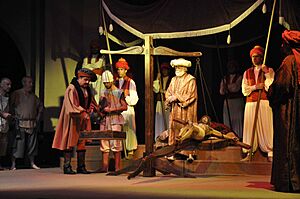Salomó facts for kids
Quick facts for kids
Salomó
|
||
|---|---|---|
|
Municipality
|
||
|
||
| Country | ||
| Community | ||
| Province | Tarragona | |
| Comarca | Tarragonès | |
| Area | ||
| • Total | 12.2 km2 (4.7 sq mi) | |
| Elevation | 158 m (518 ft) | |
| Population
(2018)
|
||
| • Total | 564 | |
| • Density | 46.23/km2 (119.7/sq mi) | |
| Demonym(s) | Salomonenc | |
| Postal code |
43885
|
|
Salomó is a small town in Catalonia, Spain. It's located in an area called Tarragonès. This town is famous for its special "Ball del Sant Crist de Salomó" (Dance of the Holy Christ of Salomó). This is a very old play that has been named a "National Traditional Festival" by the government of Catalonia.
Contents
Where is Salomó?
Salomó is in the northeast part of Tarragonès. It's close to other areas like Alt Camp and Baix Penedès. The town is about 20 kilometers from the cities of Tarragona, Valls, and el Vendrell. You can easily get there using highways like AP-7 and AP-2. Salomó even has its own train station.
The town itself sits in a small valley. It's surrounded by hills and mountains. The Gaià River flows along the western edge of the town's land. It has carved out a deep valley there.
Salomó's Past
People lived in the Salomó area a very long time ago, even before written history. We know this from old tools and pottery found in the Vergerars Cave. These items are from about 4,000 to 5,000 years ago.
The first written records about Salomó are from the early 11th century. At that time, the area was part of the Castle of Castellví de la Marca. Later, in the 13th century, a noblewoman gave the land to a monastery. King James I and later King John I protected Salomó. For many years, the town was ruled by both the monastery and a family called Copons.
In the late 1800s, Salomó faced some tough times. It was affected by a war called the Third Carlist War. A serious illness called cholera also spread in 1885. Then, in 1892, a tiny insect called phylloxera destroyed many grapevines.
During the 20th century (the 1900s), many people moved away from Salomó to bigger cities. This is called "rural exodus." Because of this, the town's population dropped by half.
How Salomó Makes a Living
Over the last few decades, how people work in Salomó has changed a lot. Fewer people work in farming now. More people work in factories or in jobs that provide services.
Still, farming is very important to Salomó's economy. The main crops grown are grapes and olives. Farmers also grow carob trees and palm trees.
Salomó also has many small businesses. These include traditional workshops like sawmills and carpentry shops. There are also factories that make things like paints, caps, and swimwear. You can find furniture stores, a rabbit slaughterhouse, and many restaurants. These restaurants get their supplies from local butchers, bakers, and grocery stores.
Historic Buildings
Church of Santa Maria
The main church in Salomó is called the Church of Santa Maria. It has been around since the 13th century. You can see old Romanesque style parts in its design. The main entrance has a round arch with a special checkerboard pattern. There's also a window with two arched openings.
Chapel of Sant Crist
Next to the Church of Santa Maria is the Chapel of Sant Crist. It was built in the early 1700s in a style called Baroque. Inside, it has a cross shape, and the center is covered by a beautiful dome. The dome has paintings of the four evangelists. The walls are decorated with paintings by a local artist named Pons i Monravà.
Cal Cadernal
Among the old houses, Cal Cadernal is very special. It was the home of the Nin family, who were important traders in Salomó. This family is part of the legend of the Holy Christ. The house is very old, but it was made much bigger and updated in the 17th century. It has unique doors and windows. A long, strong wall with battlements, also from the 17th century, surrounds the house.
Town Hall and Old Schools
The Town Hall and the old school buildings are part of one complex. They were designed by a famous architect named César Martinell. These buildings were constructed between 1924 and 1925. They helped to organize the town center and connect it to the main road.
Festivals and Traditions
The biggest festival in Salomó is the Major Festival. It honors the Holy Christ, who is the town's patron saint. This festival happens on May 3rd. It started in the late 1600s. A special part of it is the solemn Blessed Bread Procession.
In late August, Salomó celebrates its Summer Festivals. These are fun and popular events. On August 16th, there's a special feast day for Saint Roch. He is believed to protect people from diseases. This day was chosen in 1885 to remember a cholera outbreak that affected the town.
The Christmas season ends with the Three Kings Parade on January 5th. The Three Kings give toys to children from house to house. They sing a unique song that only happens in Salomó.
The Speaking Dance of the Holy Christ
Every year, during the first four Sundays of May, Salomó performs the Dance of the Holy Christ of Salomó. This is a "speaking dance." It tells a very old story through acting and dancing. The story is about a Salomó merchant, Josep Nin, who brought a special Crucifix to the town. He bought it from a merchant in Algeria.
This story began in the mid-1500s. People from nearby areas started coming to Salomó to honor the Holy Christ. A group was formed to honor him in 1691. Songs were also written about him. The words for the Dance came from these songs and old stories. The play was written down in the mid-1800s and has been performed every year since then.
Sister Cities
Salomó has special friendships with two other towns: Bree in Belgium and Volpago in Italy. These towns are called "sister cities." Every two years, people from all three towns meet. They share their cultures and learn from each other.
See also
 In Spanish: Salomó para niños
In Spanish: Salomó para niños






